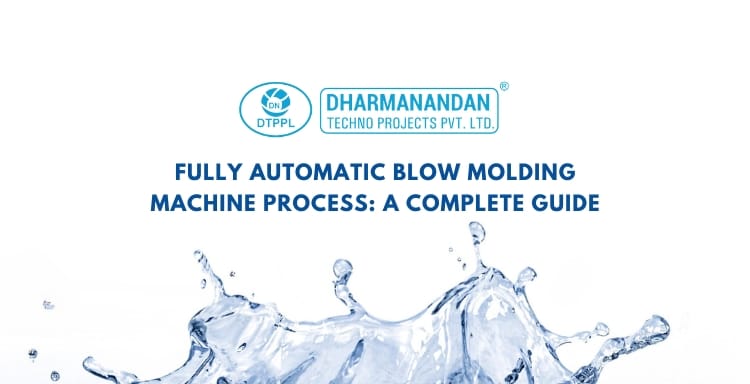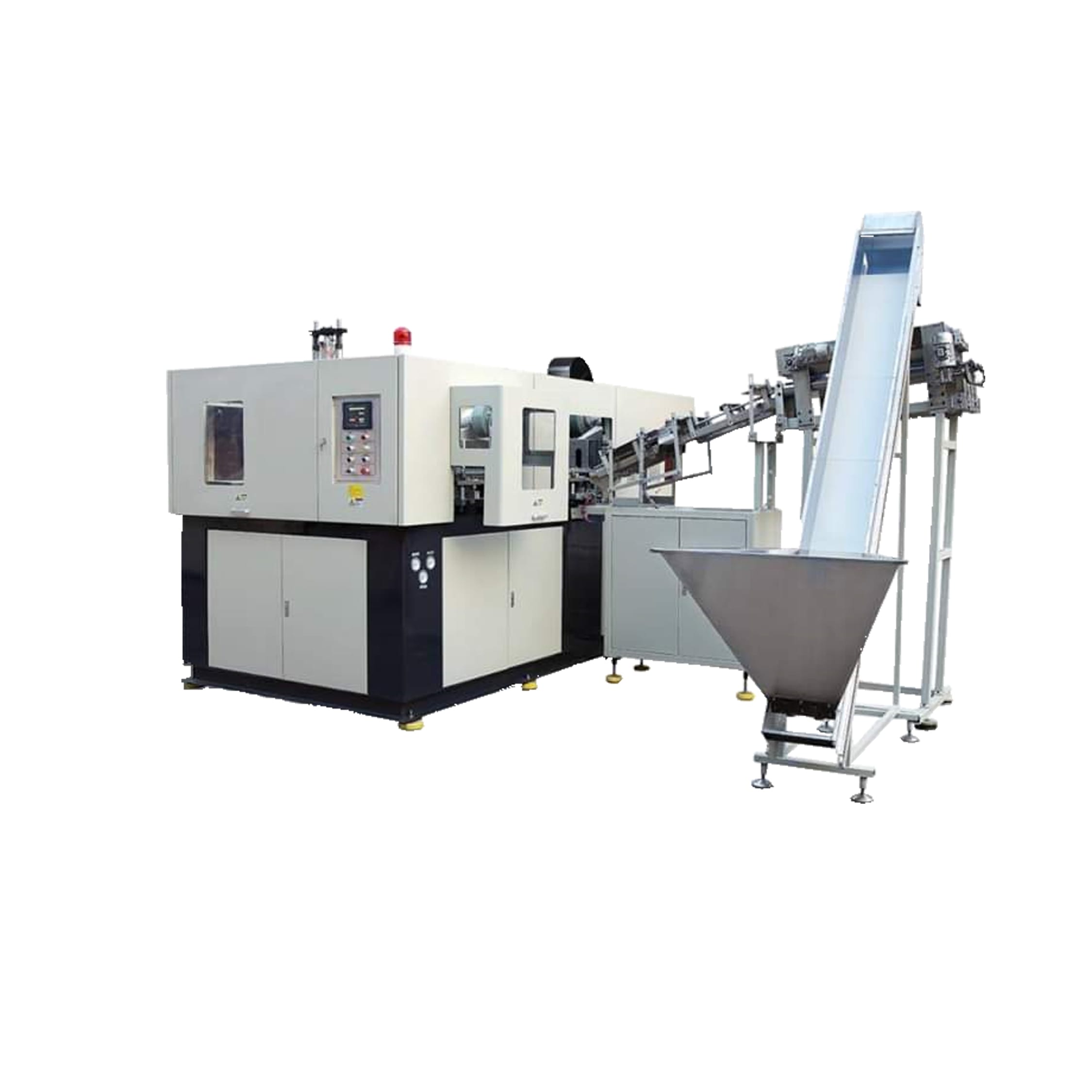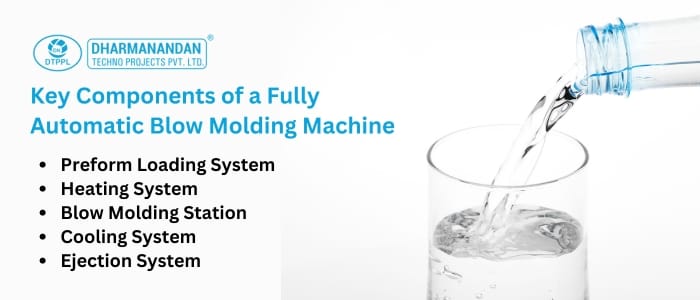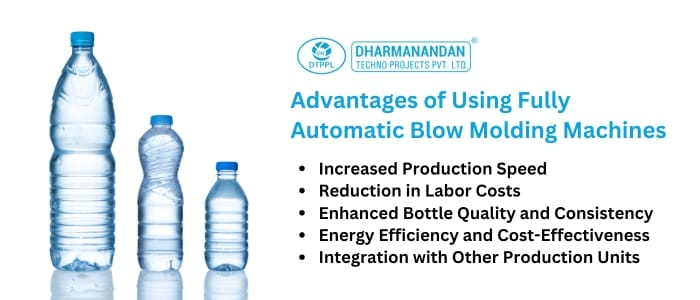
Table of Contents
Fully Automatic Blow Molding Machine Process: A Complete Guide
January 31, 2025
In the ever-evolving packaging industry, fully automatic blow molding machines have become indispensable for the production of PET bottles used in water treatment plants and soft drink production lines. These high-tech Blow Moulding Machines ensure precision, speed, and cost-effectiveness while maintaining stringent hygiene standards.
This article provides an in-depth analysis of the technical process behind fully automatic PET stretch blow molding machines, focusing on their integration into Packaged Drinking Water and Packaged Natural Mineral Water Plants and the role of compressors, refrigerated air dryers, chillers, and mold engineering in ensuring top-quality production.


Key Components of a Fully Automatic Blow Molding Machine
Understanding the various components of a fully automatic blow molding machine is essential to optimize efficiency and resolve potential production issues.
1. Preform Loading and Orientation
Preform Loading System: The system is designed for continuous and automated feeding of PET preforms into the heating chamber. It minimizes manual handling, reducing contamination risks and ensuring a steady production flow.
Advanced Vision Systems: High-resolution cameras and AI-based quality control systems detect defects such as black specks, crystallization, and dimensional inconsistencies in preforms. These systems also inspect the neck finish for structural accuracy.
Rejection Mechanisms: Automated diverters, pneumatic actuators, and robotic arms remove defective preforms from the line, ensuring only flawless ones move forward to the heating process.
Preform Handling & Singulation: Vibratory bowl feeders and escapement mechanisms ensure preforms are correctly spaced and aligned for precise processing.
2. Preform Heating Process
Infrared Heating System: Short-wave and medium-wave infrared lamps evenly heat preforms, optimizing energy efficiency while preventing overheating.
Spectral Absorption of PET: PET absorbs specific infrared wavelengths, and the heating system is calibrated to match these absorption rates for optimal preform plasticity.
Zoned Temperature Control: Multiple temperature control zones ensure gradual and uniform heating. Each zone has independent control via PID controllers, which automatically adjust heat levels based on sensor feedback.
Preform Rotation: Continuous rotation inside the heating chamber ensures symmetrical heating, preventing sagging or uneven expansion.
3. Stretch Blow Molding Process
Mold Clamping System: Ensures tight sealing during the blowing process. Smaller PET Blow Moulding Machines use toggle mechanisms for faster cycling, whereas hydraulic clamping is preferred for high-force, industrial applications.
Stretch Rods: Servo-controlled rods extend inside the preform, ensuring even material distribution, enhancing bottle durability and transparency.
Low-Pressure Pre-Blow Phase: The initial expansion process ensures even material stretching, reducing defects such as pearlescence or uneven thickness.
High-Pressure Blowing (Final Blow): Rapid high-pressure air injection (8-40 bar) expands the preform into the mold cavity. Advanced valve technology ensures quick air delivery for high-speed production.
Biaxial Orientation: The stretching and blowing process aligns the PET molecules in two directions, improving strength, clarity, and gas barrier properties.
4. Cooling and Ejection Process
Turbulent Flow Cooling: Mold cooling channels are designed for efficient heat transfer, ensuring bottles solidify quickly without distortion.
Conformal Cooling: 3D-printed mold channels allow uniform cooling across the bottle’s surface, reducing residual stresses and preventing deformations.
Air and Ejector Pin Systems: Pneumatic ejectors and air-assisted systems smoothly remove bottles from the mold without causing damage.
Automated Stacking System: Conveyor mechanisms automatically stack the bottles and transfer them for filling, reducing manual handling and contamination risks.

The Interplay of Key Components in Water Treatment and Soft Drink Production Lines
1. Compressors and Air Dryers
High-Pressure Compressors (25-40 bar): Multi-stage compression technology ensures a reliable supply of high-pressure air required for the blowing process. Intercoolers are integrated to regulate temperature and improve energy efficiency.
Low-Pressure Compressors (8-12 bar): Essential for the pre-blow phase and auxiliary machine functions such as mold actuation and conveyor movements.
Refrigerated Air Dryers: Removes moisture from compressed air to prevent condensation and contamination in PET bottles, maintaining bottle clarity and quality.
2. Chillers and Cooling Systems
Heat Exchanger Optimization: Uses shell-and-tube or plate heat exchanger designs to maximize cooling efficiency while minimizing energy consumption.
Cooling Capacity Control: Chillers employ variable-speed drives and hot gas bypass systems to adjust cooling levels according to production demands, reducing energy waste.
3. Mold Engineering & Automation
CNC Precision Molds: Designed to achieve accurate bottle dimensions and uniform weight distribution.
HMI (Human-Machine Interface): Allows operators to monitor and adjust Polyethylene Terephthalate Blow Moulding Machine parameters in real time, optimizing production efficiency.
PLC Control Systems: Automates the entire production sequence, including heating, stretching, and blowing. Predictive maintenance features detect potential faults before failures occur.
Advantages of Using Fully Automatic Blow Molding Machines
1. Increased Production Speed
Fully automatic blow molding machines are capable of producing thousands of PET bottles per hour, ensuring high-speed mass production. Their advanced automation reduces cycle times, increasing output without compromising quality.
2. Reduction in Labor Costs
Automation significantly reduces dependency on manual labor, minimizing operational costs. With fewer human interventions required, businesses can allocate labor resources to other critical production areas, improving overall Fully Automatic Blow Moulding Machine efficiency.
3. Enhanced Bottle Quality and Consistency
With precise control over heating, stretching, and blowing, these machines ensure uniform wall thickness, superior strength, and crystal-clear transparency in every bottle. Advanced quality control systems further eliminate defects and ensure consistency across all production batches in Fully Automatic PET Blow Moulding Machine.
4. Energy Efficiency and Cost-Effectiveness
Modern fully automatic blow molding machines are designed with energy-saving technologies, including optimized heating systems and intelligent power management. These features help reduce electricity consumption while maintaining high performance, leading to lower operational costs.
5. Integration with Other Production Units
These machines seamlessly integrate with water treatment and soft drink production lines, including filling, capping, and labeling machines, ensuring a smooth, uninterrupted workflow from bottle formation to final packaging.

Environmental & Safety Considerations
Noise Pollution Mitigation: Modern blow molding machines incorporate sound enclosures and vibration damping to minimize operational noise.
Energy Efficiency: Intelligent power management and low-energy IR lamps significantly reduce operational costs.
Sustainability Initiatives: Increasing industry-wide adoption of recycled PET (rPET) and ongoing research into biodegradable PET materials for eco-friendly packaging.

Future Trends in Blow Molding Technology
AI-Driven Quality Control: Real-time AI-assisted defect detection enhances product consistency and minimizes waste.
IoT & Industry 4.0 Integration: Smart connectivity enables predictive maintenance for Polyethylene Terephthalate Blow Molding Machine and efficiency tracking via cloud-based monitoring.
Eco-Friendly Materials: Industry research focuses on alternative sustainable plastics, reducing environmental impact.
Lightweighting Techniques: Engineering innovations aim to maintain structural integrity while using less material, lowering production costs and carbon footprint.
Fully Automatic Blow Molding Machine
Capacity: 2400 BPH to 12000 BPH
Conclusion
Partner with Dharmanandan Techno Projects Pvt. Ltd. (DTPPL) for Advanced Blow Molding Solutions
Dharmanandan Techno Projects Pvt. Ltd. (DTPPL) is a leader in designing and manufacturing fully automatic blow molding machines tailored for water treatment plants and soft drink production lines. With a commitment to cutting-edge technology, energy efficiency, and sustainability, DTPPL provides reliable and high-performance solutions that ensure seamless integration with bottling and packaging systems.
Whether you are looking to scale production, enhance efficiency, or invest in eco-friendly PET bottle manufacturing, DTPPL has the expertise and innovation to support your business. Contact DTPPL today to explore how our state-of-the-art PET Blow Molding Machines can transform your manufacturing process.
As industries push for efficiency and sustainability, Fully Automatic PET Blow Molding Machines remain a cornerstone in water treatment plants and soft drink production lines. Their ability to produce high-quality PET bottles at scale, while integrating seamlessly with water bottling and packaging systems, ensures that businesses stay ahead in an increasingly competitive market.
By leveraging advanced automation, energy efficiency, and precision engineering, manufacturers can achieve higher productivity, better cost management, and compliance with environmental standards in the bottled water and beverage industry.
FAQs about Fully Automatic Blow Molding Machine Process
Preform loading involves placing the preform into the machine’s mold cavity. This step is crucial as it sets the stage for the subsequent heating and stretching processes, ensuring the final product’s shape and strength.
The preform heating process uses infrared heaters to uniformly heat the preform. This softens the plastic, making it pliable enough to be stretched and blown into the desired shape within the mold.
Stretch blow molding enhances the strength and clarity of the plastic container. By stretching the preform both axially and radially before blowing it into the mold, the process aligns the polymer molecules, resulting in a more robust and transparent product.
Cooling solidifies the molded plastic, locking in the desired shape and dimensions. Efficient cooling ensures uniform thickness and prevents warping, contributing to the structural integrity of the final product.
The pneumatic wedge lock clamping system plays a critical role by securely holding the mold during the blowing phase. This mechanism prevents any movement, ensuring that the mold maintains its shape and the final product meets the specified dimensions and quality standards.
During the blowing process, the preheated preform is inflated using high-pressure air to conform to the mold’s shape. This step is crucial for determining the bottle’s final dimensions, wall thickness and structural integrity, ensuring that the product is both functional and durable.
About Author

Director – Global Marketing and Sales
Mr. Bhavesh from Dharmanandan Techno Projects Pvt. Ltd. has played a pivotal role in elevating the DTPPL brand to the global stage, leveraging his exceptional expertise in marketing and communications. He is committed to helping clients achieve significant growth while strengthening their own brands. Dharmanandan Techno Projects Pvt. Ltd. is a leading manufacturer and supplier of water purification systems and turnkey solutions for mineral water plants. With years of experience in designing and delivering high-quality water treatment solutions, the company provides end-to-end services, including system design, installation, maintenance, and ongoing support. Specializing in scalable and customizable water plants, DTPPL has successfully served industries worldwide, ensuring clean and safe drinking water across diverse applications.




